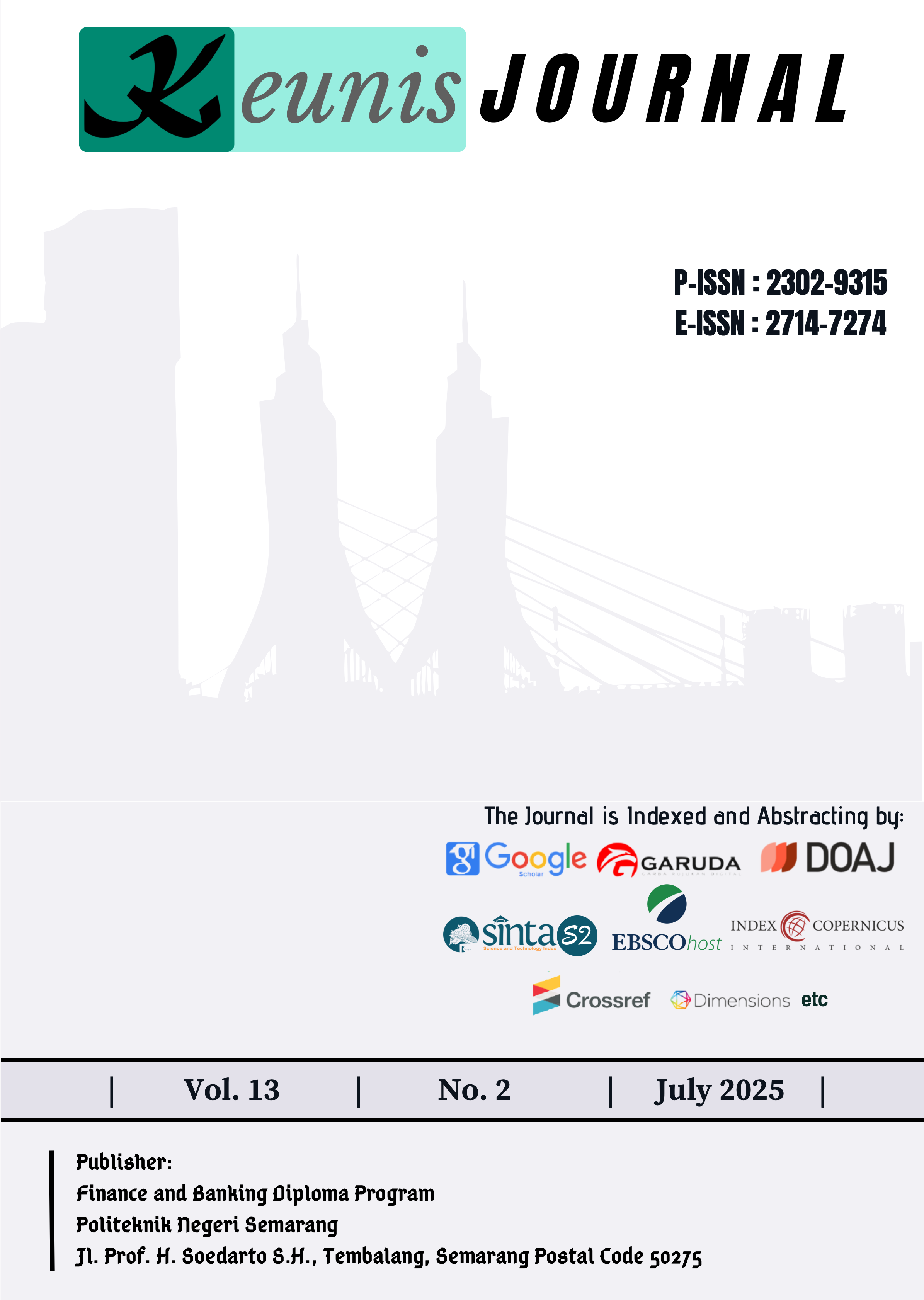Loss Aversion, Regret Aversion, Herding in Fraudulent Investment Decisions Moderated by Financial Literacy
DOI:
https://doi.org/10.32497/keunis.v13i2.6302Keywords:
loss aversion, regret aversion, herding, financial literacy, fraudulent investment decisionAbstract
Fraudulent investment schemes continue to deceive the public despite ongoing improvements in financial literacy across Indonesia. This phenomenon presents a serious threat to personal financial management, as many individuals are still lured by promises of unrealistic profits and pressured into high-risk financial traps. These schemes exploit specific psychological vulnerabilities that influence decision-making. This study aims to examine the influence of three behavioral loss aversion, regret aversion, and herding on fraudulent investment decisions, with financial literacy analyzed as a moderating variable. Total of 100 respondents in Semarang who had experienced financial losses due to fraudulent investment practices were selected using purposive and snowball sampling methods. Data were analyzed using feasibility tests, classical assumption testing, multiple regression analysis, and moderated regression analysis (MRA). The findings reveal that loss aversion and regret aversion both have a significant negative effect on fraudulent investment decisions, while herding has a positive influence. Additionally, financial literacy plays a quasi-moderating role, effectively weakening the impact of these psychological traits. These findings underscore the importance of psychological factors in irrational financial behaviors and highlight the critical need for improved financial literacy education. Strengthening financial awareness may help reduce vulnerability to deceptive investment offers and promote healthier financial decision-making.
References
Ainia, N. S. N., & Lutfi, L. (2019). The influence of risk perception, risk tolerance, overconfidence, and loss aversion on investment decision-making. Journal of Economics, Business, & Accountancy Ventura, 21(3), 401–413. https://doi.org/10.14414/jebav.v21i3.1663
Alamsyah, M. I., Huda, M., & Pranata, R. M. (2023). Herding as behavior investing: A bibliometric analysis. JAAF (Journal of Applied Accounting and Finance), 7(1), 28. https://doi.org/10.33021/jaaf.v7i1.4141
Alsmadi, A. A. (2022). Financial Literacy: A Bibliometric Analysis for the Period of 1990-2021. International Journal of New Trends in Social Sciences, 6(1), 34–44. https://doi.org/10.18844/ijss.v6i1.7469
Aprilianti, A. A., Tanzil, N. D., & Pratama, A. (2023). Herding Behavior, Loss Aversion Bias, Financial Literacy, and Investment Decisions (a Study on Millennial Generation in Indonesia in the Digital Era). JASa (Jurnal Akuntansi, Audit Dan Sistem Informasi Akuntansi), 7(3), 555–565. https://doi.org/10.36555/jasa.v7i3.2301
Asari, A., Zulkarnaini, Hartatik, Anam, A. C., Suparto, Litamahuputty, J. V., Mubina, F., Dewadi, Prihastuty, D. R., Maswar, Syukrilla, W. A., Murni, N. S., & Sukwika, T. (2023). Pengantar Statistika (A. Asari (ed.); 1st ed.). PT Mafy Media Literasi Indonesia.
Atkinson, A., & Messy, F. A. (2011). Assessing financial literacy in 12 countries: An OECD/INFE international pilot exercise. Journal of Pension Economics and Finance, 10(4), 657–665. https://doi.org/10.1017/S1474747211000539
Ayoub, A., & Balawi, A. (2022). Herd Behavior and its Effect on the Stock Market: An Economic Perspective. Quality - Access to Success, 23(188), 285–289. https://doi.org/10.47750/QAS/23.188.38
Banerjee, A. V. (1992). Herding, social influence and expert opinion. Journal of Economic Methodology, 107(3), 797–817. https://doi.org/10.1080/1350178X.2013.774845
Bell, D. E. (1982). Regret in Decision Making under Uncertainty. 30(5), 961–981. http://www.jstor.org/stable/170353?origin=JSTOR-pdf
Bibi, K., Ur Rahman, S., & Sufyan Qayum, A. (2023). Decoding Investor Decision-Making: Unraveling Psychological Factors and Educational Moderation in Financial Markets. Global Economics Review, VIII(III), 1–14. https://doi.org/10.31703/ger.2023(viii-iii).01
BPS Kota Semarang. (2024). Kota Semarang Dalam Angka 2024. In Semarang Municipality in Figures (Vol. 51). BPS Kota Semarang.
Budiastuti, D., & Bandur, A. (2018). Validitas dan Reliabilitas Penelitian Dengan Analisis dengan NVIVO, SPSS dan AMOS (1st ed.). Mitra Wacana Media.
Bunyamin, M., & Wahab, N. A. (2022). IMPACT OF FINANCIAL LITERACY ON FINANCE AND ECONOMY: A LITERATURE REVIEW. Labuan Bulletin of International Business and Finance (LBIBF), 20(2), 49–65. https://doi.org/10.51200/lbibf.v20i2.3677
Butt, H., Sajjad, A., Awan, K. Z., & Shakil, M. H. (2023). The Role of Behavioral Factors on Investment Decision Making. Pakistan Journal of Humanities and Social Sciences, 11(4). https://doi.org/10.52131/pjhss.2023.v11i4.1876
Cao, M. M., Nguyen, N. T., & Tran, T. T. (2021). Behavioral Factors on Individual Investors’ Decision Making and Investment Performance: A Survey from the Vietnam Stock Market. Journal of Asian Finance, Economics and Business, 8(3), 845–853. https://doi.org/10.13106/jafeb.2021.vol8.no3.0845
Cortés, R. L. de G., Tolosa, L. E., & Rojo, M. P. (2023). Prospect theory in the financial decision-making process: an empirical study of two Argentine universities. Journal of Economics, Finance and Administrative Science, 28(55), 116–133. https://doi.org/10.1108/JEFAS-12-2021-0272
Dhall, R., & Singh, B. (2020). The COVID-19 Pandemic and Herding Behaviour: Evidence from India’s Stock Market. Millennial Asia, 11(3), 366–390. https://doi.org/10.1177/0976399620964635
Dhungana, B. R., Bhandari, S., Ojha, D., & Sharma, L. K. (2022). Effect of Cognitive Biases on Investment Decision Making. Quest Journal of Management and Social Sciences, 4(1), 71–84. https://doi.org/10.3126/qjmss.v4i1.45868
Din, S. M. U., Mehmood, S. K., Shahzad, A., Ahmad, I., Davidyants, A., & Abu-Rumman, A. (2021). The Impact of Behavioral Biases on Herding Behavior of Investors in Islamic Financial Products. Frontiers in Psychology, 11(February), 1–10. https://doi.org/10.3389/fpsyg.2020.600570
Fan, H. (2024). A Critical Comparison of SEUT and Prospect Theory. Advances in Economics, Management and Political Sciences, 72(1), 105–111. https://doi.org/10.54254/2754-1169/72/20240690
Ferdinand, A. (2014). Metode Penelitian Manajemen (5th ed.). UNDIP Press.
Firmansyah, Winarno, A., & Siswanto, E. (2023). The Influence of Overconfidence Bias, Herding Effect, and Loss Aversion on Investment Decisions in The Capital Market with Financial Literacy as A Moderating Variable. Journal of Business and Management Review, 4(11), 871–897. https://doi.org/10.47153/jbmr411.8252023
Fitriyani, S., & Anwar, S. (2022). PENGARUH HERDING, EXPERIENCE REGRET DAN RELIGIOSITY TERHADAP KEPUTUSAN INVESTASI SAHAM SYARIAH PADA INVESTOR MUSLIM MILLENNIAL DENGAN FINANCIAL LITERACY SEBAGAI VARIABEL MODERASI. Jurnal Ekonomi Syariah Teori Dan Terapan, 9(1), 68. https://doi.org/10.20473/vol9iss20221pp68-77
Gao, R. (2023). Research on Loss Aversion and Its Formation in Prospect Theory. Advances in Economics, Management and Political Sciences, 10(1), 232–237. https://doi.org/10.54254/2754-1169/10/20230472
Ghozali, I. (2021). Aplikasi Analisis Multivariate (10th ed.). Badan Penerbit - Undip.
Hariono, M. W., Cahyadi, R. T., & Wijayanti, D. (2023). Pengaruh Bias Perilaku terhadap Pengambilan Keputusan Irasional dengan Financial Literacy sebagai Pemoderasi. Jurnal Samudra Ekonomi Dan Bisnis, 14(1), 1–14. https://doi.org/10.33059/jseb.v14i1.5304
Hidajat, T. (2018). Financial Literacy, Ponzi and Pyramid Scheme in Indonesia. Jurnal Dinamika Manajemen, 9(2), 198–205. https://doi.org/10.15294/jdm.v9i2.16261
Hidajat, T. (2020). Predator and prey: Ponzi and pyramid investors (1st ed.).
Holly, A., Jao, R., & Limang, A. (2022). Perilaku Bias Emosional dan Risk Tolerance dalam Pengambilan Keputusan Investasi. Muhammadiyah Riau Accounting and Business Journal, 4(1), Press. https://doi.org/10.37859/mrabj.v4i1.4036
Hussain, M., Sadiq, S., Rasheed, M. H., & Amin, K. (2022). Exploring the Dynamics of Investors’ Decision Making in Pakistan Stock Market: A Study of Herding Behavior. Journal of Economic Impact, 4(1), 165–173. https://doi.org/10.52223/jei4012220
Hussain, M., Zulfiqar, B., Shafique, A., Malik, L., & Ashraf, P. (2023). The Impact of Herding, Loss Aversion, and Cognitive Dissonance on Individual Investor’s Investment Decision Making: Moderating Role of Financial Literacy. Jinnah Business Review, 11(2), 1–19. https://doi.org/10.53369/znll7178
Iswahyudi, A. (2023). Pengaruh Investasi Bodong Terhadap Minat Investasi Masyarakat (Studi Pada Masyarakat Kelurahan Sabbamparu Kecamatan Wara Utara Kota Palopo) [IAIN Palopo]. http://repository.iainpalopo.ac.id/id/eprint/7919
Júlia, G.-P., Manuel, M.-V., & Francisco, G.-S. (2022). Prospect Theory: A Bibliometric and Systematic Review in the Categories of Psychology in Web of Science. Healthcare (Switzerland), 10(10). https://doi.org/10.3390/healthcare10102098
Kahneman, D., & Tversky, A. (1979). Prospect Theory: An Analysis of Decision Under Risk. World Scientific Handbook in Financial Economic Series., 47(2), 263–291. https://doi.org/doi.org/10.1142/9789814417358_0006
Khan, D. (2020). Cognitive Driven Biases, Investment Decision Making: The Moderating Role of Financial Literacy. SSRN Electronic Journal, 1–25. https://doi.org/10.2139/ssrn.3514086
Khan, W. U., Shachak, A., & Seto, E. (2022). Understanding Decision-Making (7) in the Adoption of Digital Health Technology: The Role of Behavioral Economics’ Prospect Theory. Journal of Medical Internet Research, 24(2), 1–4. https://doi.org/10.2196/32714
Koma, D. R. A., & Jatiningsih, D. E. S. (2024). The Effect of Overconfidence Bias, Risk Tolerance, and Herding Bias on Stock Investment Decisions with Financial Literacy as a Moderation Variable. KnE Social Sciences, 2024, 303–336. https://doi.org/10.18502/kss.v9i21.16718
Kononovych, T., & Myasoid, P. (2020). Prospects Theory and Individual Style of Economic Decision-Making. Problems of Psychology in the 21st Century, 14(1), 54–63. https://doi.org/10.33225/ppc/20.14.54
Kumar, S., & Chaurasia, A. (2024). The relationship between emotional biases and investment decisions. IIMT Journal of Management. https://doi.org/10.1108/iimtjm-03-2024-0034
Kuria, A. M. (2024). Herding Bias And Investment Performance. IOSR Journal of Economics and Finance, 15(6), 37–41. https://doi.org/10.9790/5933-1506033741
Liu, Y. (2023). The Review of Loss Aversion. Advances in Education, Humanities and Social Science Research, 7(1), 428. https://doi.org/10.56028/aehssr.7.1.428.2023
Loppies, L. S., Maria J.F Esomar1, M. J. ., & Janah, I. N. (2022). Herding Behavior, Overconfidence, Regret Aversion Bias On Investment Decisions. International Journal of Economics, Social Science, Entrepreneurship and Technology (IJESET), 1(5), 345–352. https://doi.org/10.55983/ijeset.v1i5.357
Lusardi, A., & Messy, F.-A. (2023). The importance of financial literacy and its impact on financial wellbeing. Journal of Financial Literacy and Wellbeing, 1(1), 1–11. https://doi.org/10.1017/flw.2023.8
Mahadevi, S. A., & Haryono, N. A. (2021). Pengaruh Status Quo, Herding Behaviour, Representativeness Bias, Mental Accounting, serta Regret Aversion Bias terhadap Keputusan Investasi Investor Milenial di Kota Surabaya. Jurnal Ilmu Manajemen, 9(2), 779. https://doi.org/10.26740/jim.v9n2.p779-793
Midgley, J. (2017). Social investment: concepts, uses and theoretical perspectives. In Social Investment and Social Welfare (pp. 13–32). Edward Elgar Publishing. https://doi.org/10.4337/9781785367830.00007
Nalurita, F., Leon, F. M., & Hady, H. (2020). Factor Influencing Investor’s Decision Making in Indonesia: Moderating the Role of Locus of Control. International Journal of Business and Applied Social Science, 49–56. https://doi.org/10.33642/ijbass.v6n4p6
Novianggie, V., & Asandimitra, N. (2019). The Influence of Behavioral Bias, Cognitive Bias, and Emotional Bias on Investment Decision for College Students with Financial Literacy as the Moderating Variable. International Journal of Academic Research in Accounting, Finance and Management Sciences, 9(2), 92–107. https://doi.org/10.6007/IJARAFMS/v9-i2/6044
Nursalimah, E., & Utami, I. (2022). Pengaruh Regret Aversion Bias dan Overconfidence Terhadap Pengambilan Keputusan Investasi Cryptocurrency Pada Investor Generasi Milenial. Robust: Research of Business and Economics Studies, 2(1), 63. https://doi.org/10.31332/robust.v2i1.3953
Pangestu, A., & Bagana, B. D. (2022). Faktor-Faktor Yang Mempengaruhi Minat Investasi Generasi Milenial di Kota Semarang. E-Bisnis : Jurnal Ilmiah Ekonomi Dan Bisnis, 15(2), 212–220. https://doi.org/10.51903/e-bisnis.v15i2.671
Pompian, M. M. (2011). Behavioral finance and wealth management: How to build investment strategies that account for investor biases. In Behavioral Finance and Wealth Management: How to Build Investment Strategies That Account for Investor Biases. https://doi.org/10.1002/9781119202400
Prayudi, R. M. N., & Purwanto, E. (2023). The Impact of Financial Literacy, Overconfidence Bias, Herding Bias and Loss Aversion Bias on Investment Decision. Indonesian Journal of Business Analytics, 3(5), 1873–1886. https://doi.org/10.55927/ijba.v3i5.5715
Putri, G. T. M., & Santoso, B. (2024). Sistem Investasi Di Indonesia. TOMAN: Jurnal Topik Manajemen, 1(2), 303–316. https://doi.org/https://doi.org/10.61930/toman.v1i2.98
Putri, I. D. R., & Sudiyatno, B. (2023). The Influence Of Financial Literacy, Herding And Regret Aversion Bias On The Investment Decisions Of The Millenial Generation. Management Studies and Entrepreneurship Journal, 4(4), 4198–4209. http://journal.yrpipku.com/index.php/msej
Putri, I. R., & Hikmah. (2020). Pengaruh Financial Literacy, Overconfidence, Regret Aversion Bias dan Risk Tolerance Terhadap Investment Decision di Kota Batam. Junral IIlmiah Maksitek, 5(2), 95–109. https://doi.org/https://makarioz.sciencemakarioz.org/index.php/JIM/article/view/154
Qiao, S. (2023). Loss Aversion and Protectionism. Advances in Economics, Management and Political Sciences, 15(1), 99–104. https://doi.org/10.54254/2754-1169/15/20230878
Rahadi, D. R., & Farid, M. (2021). Analisis Variabel Moderating (P. Adi & M. Muslih (eds.); 1st ed., Vol. 7, Issue 2). CV. Lentera Ilmu Mandiri.
Ranaweera, S. S., & Kawshala, B. A. H. (2022). Influence of Behavioral Biases on Investment Decision Making with Moderating Role of Financial Literacy and Risk Attitude: A Study Based on Colombo Stock Exchange. South Asian Journal of Finance, 2(1), 56–67. https://doi.org/10.4038/sajf.v2i1.32
Rani, M., & Siwach, M. (2023). Financial Literacy in India: A Review of Literature. Economic and Regional Studies / Studia Ekonomiczne i Regionalne, 16(3), 446–458. https://doi.org/10.2478/ers-2023-0029
Salvatore, T., & Esra, M. A. (2020). PENGARUH OVERCONFIDENCE, HERDING, REGRET AVERSION, DAN RISK TOLERANCE TERHADAP PENGAMBILAN KEPUTUSAN INVESTASI INVESTOR. Jurnal Manajemen, 10(1), 48–56. https://doi.org/10.46806/jm.v10i1.699
Santoso, A. P., & Safariah, T. (2023). Pengaruh Illusion of Control Bias Dan Regret Aversion Bias Terhadap Keputusan Penempatan Dana Untuk Modal Usaha Pada …. Researchgate.Net, December. https://doi.org/https://www.researchgate.net/publication/376683438 PENGARUH
Sharma, S., Durand, R. M., & Gur-Arie, O. (1981). Identification and Analysis of Moderator Variables. Journal of Marketing Research, 18(3), 291. https://doi.org/10.2307/3150970
Silalahi, P. R., Syahputri, R. R., Prayoga, R., & Meianti, A. (2022). Pentingnya Literasi Keuangan Bagi Masyarakat Agar Tidak Tertipu Investasi Bodong: Studi Kasus Binomo. El-Mujtama: Jurnal Pengabdian Masyarakat, 2(3), 346–355. https://doi.org/10.47467/elmujtama.v2i3.1901
Sugiyono. (2020). Metode Penelitian Kuantitatif Kualitatif dan R&D (Sutopo (ed.); 2nd ed.).
Suprasta, N., & Nuryasman. (2020). Faktor-Faktor Yang Mempengaruhi Pengambilan Keputusan Investasi Saham. Jurnal Ekonomi, 25(2), 251. https://doi.org/10.24912/je.v25i2.669
Tambunan, D., & Hendarsih, I. (2022). Waspada Investasi Ilegal di Indonesia. Jurnal Perspektif, 20(1), 108–114. https://doi.org/10.31294/jp.v20i1.12518
Tandelilin, E. (2010). Dasar-dasar Manajemen Investasi. https://pustaka.ut.ac.id/lib/wp-content/uploads/pdfmk/EKMA5312-M1.pdf
Thaler, R. H., Tversky, A., Kahneman, D., & Schwartz, A. (1997). The effect of myopia and loss aversion on risk taking: An experimental test. Quarterly Journal of Economics, 112(2), 646–661. https://doi.org/10.1162/003355397555226
Tiurina, A., Orel, M., Lisovska, L., Yurynets, O., & Prokopenko, N. (2023). The Essence of the Development of Social Investment Projects for the Economy. Economic Affairs (New Delhi), 68(3), 1675–1681. https://doi.org/10.46852/0424-2513.3.2023.32
Trisno, B., & Vidayana. (2023). Understanding herding behavior among Indonesian stock market investors. E3S Web of Conferences, 426, 01088. https://doi.org/10.1051/e3sconf/202342601088
Valencia, W. A., Chávez, O. C. M., & Carhuancho, M. G. L. (2020). Investment projects: definition from the process perspective. Cuadernos de Administración, 36(66), 161–171. https://doi.org/10.25100/cdea.v36i66.7221
Wahyuni, A. N., & Lukiastuti, F. (2019). Penilaian Kinerja Keuangan Perusahaan Manufaktur Dengan Inflasi Sebagai Variabel Moderasi. ECONBANK: Journal of Economics and Banking, 1(1), 61–78. https://doi.org/10.35829/econbank.v1i1.3
Walasek, L., Mullett, T. L., & Stewart, N. (2024). A meta-analysis of loss aversion in risky contexts. Journal of Economic Psychology, 103, 102740. https://doi.org/10.1016/j.joep.2024.102740
Wangzhou, K., Khan, M., Hussain, S., Ishfaq, M., & Farooqi, R. (2021). Effect of Regret Aversion and Information Cascade on Investment Decisions in the Real Estate Sector: The Mediating Role of Risk Perception and the Moderating Effect of Financial Literacy. Frontiers in Psychology, 12(October), 1–15. https://doi.org/10.3389/fpsyg.2021.736753
Yang, Y. (2023). The Impact of Loss Aversion on Peoples Behavior in Different Markets. Advances in Economics, Management and Political Sciences, 14(1), 345–352. https://doi.org/10.54254/2754-1169/14/20230851
Downloads
Published
Issue
Section
License
Copyright (c) 2025 The Author(s)

This work is licensed under a Creative Commons Attribution-NonCommercial-ShareAlike 4.0 International License.
KEUNIS is licensed under a Creative Commons Attribution-ShareAlike 4.0 International License.
Authors who publish with this journal agree to the following terms:
- Authors retain copyright and grant the journal right of first publication with the work simultaneously licensed under a Creative Commons Attribution-ShareAlike 4.0 International License that allows others to share the work with an acknowledgement of the work's authorship and initial publication in this journal.
- Authors are able to enter into separate, additional contractual arrangements for the non-exclusive distribution of the journal's published version of the work (e.g., post it to an institutional repository or publish it in a book), with an acknowledgement of its initial publication in this journal.
- Authors are permitted and encouraged to post their work online (e.g., in institutional repositories or on their website) prior to and during the submission process, as it can lead to productive exchanges, as well as earlier and greater citation of published work (See The Effect of Open Access).






